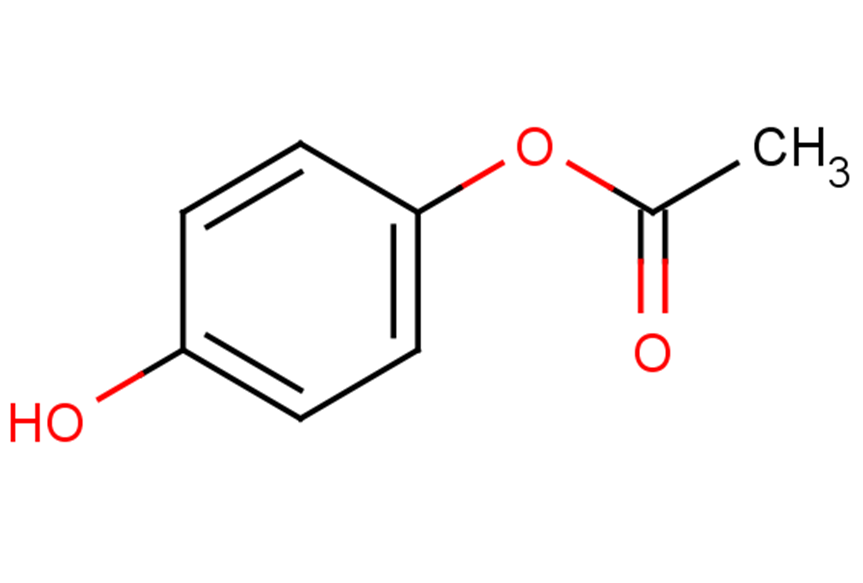
4-hydroxyphenyl acetate
CAS No. 3233-32-7
4-hydroxyphenyl acetate( —— )
Catalog No. M22549 CAS No. 3233-32-7
4-Acetoxyphenol Prevents RPE Oxidative Stress-Induced Necrosis by Functioning as an NRF2 Stabilizer4-AC is a natural antioxidant, which demonstrates strong abilities to protect RPE cells from oxidative stress-induced necrosis.
Purity : >98% (HPLC)
 COA
COA
 Datasheet
Datasheet
 HNMR
HNMR
 HPLC
HPLC
 MSDS
MSDS
 Handing Instructions
Handing Instructions
| Size | Price / USD | Stock | Quantity |
| 100MG | 26 | In Stock |


|
| 200MG | Get Quote | In Stock |


|
| 500MG | Get Quote | In Stock |


|
| 1G | Get Quote | In Stock |


|
Biological Information
-
Product Name4-hydroxyphenyl acetate
-
NoteResearch use only, not for human use.
-
Brief Description4-Acetoxyphenol Prevents RPE Oxidative Stress-Induced Necrosis by Functioning as an NRF2 Stabilizer4-AC is a natural antioxidant, which demonstrates strong abilities to protect RPE cells from oxidative stress-induced necrosis.
-
Description4-Acetoxyphenol Prevents RPE Oxidative Stress-Induced Necrosis by Functioning as an NRF2 Stabilizer4-AC is a natural antioxidant, which demonstrates strong abilities to protect RPE cells from oxidative stress-induced necrosis. Mechanistically, 4-AC blocked the increase of cellular ROS induced by oxidative stress, and upregulated NQO1 and HO-1 genes by stabilizing and inducing the nuclear translocation of NRF2 transcription factor. The NQO1, HO-1, and NRF2 were further shown to be required for 4-AC protection of RPE cells from death induced by tBHP. The tBHQ, an NRF2 stabilizer, consistently mimicked the protective effect of 4-AC against tBHP-induced RPE death.
-
In Vitro4-Hydroxyphenyl acetate (5 μM; 24 h) protects retinal pigment epithelial (RPE) cells from oxidative stress-induced cell death.4-Hydroxyphenyl acetate (5 μM; 24 h; ARPE-19 cells) inhibits the increase of ROS in response to oxidative stress and up-regulated the expression of cytoprotective genes including NQO1 and HO-1 genes. Cell Viability Assay Cell Line:ARPE-19 cells Concentration:5 μM Incubation Time:24 hours Result:Protected up to 89%, 92%, and 90% of ARPE-19 cells exposed to 100, 200, and 300 μM tBHP, respectively.
-
In Vivo——
-
Synonyms——
-
PathwayNuclear Receptor/Transcription Factor
-
TargetKeap1-Nrf2
-
RecptorNRF2
-
Research Area——
-
Indication——
Chemical Information
-
CAS Number3233-32-7
-
Formula Weight152.15
-
Molecular FormulaC8H8O3?
-
Purity>98% (HPLC)
-
SolubilityIn Vitro:?DMSO : 100 mg/mL (657.25 mM)
-
SMILESCC(=O)Oc1ccc(O)cc1
-
Chemical Name——
Shipping & Storage Information
-
Storage(-20℃)
-
ShippingWith Ice Pack
-
Stability≥ 2 years
Reference
1. Jakub H , Alexander K , Julia C , et al. 4-Acetoxyphenol Prevents RPE Oxidative Stress–Induced Necrosis by Functioning as an NRF2 Stabilizer[J]. Invest Ophthalmol Vis, 2015, 56(9):5048-5059.
molnova catalog



related products
-
TBHQ
Tert-butylhydroquinone (tBHQ) is an antioxidant that induces an antioxidant response through the redox-sensitive transcription factor Nrf2.
-
ML334
ML334 (LH601A) is a transmembrane and potent NRF2 activator that inhibits Keap1-NRF2 protein interactions to ameliorate myocardial infarction-induced cardiac fibrosis by inhibiting cardiac fibroblast activation and proliferation.
-
Dimethyl fumarate
Dimethyl fumarate (DMF;BG-12) exerts anti-inflammatory and pro-metabolic effects in a variety of cell types.



 Cart
Cart
 sales@molnova.com
sales@molnova.com


